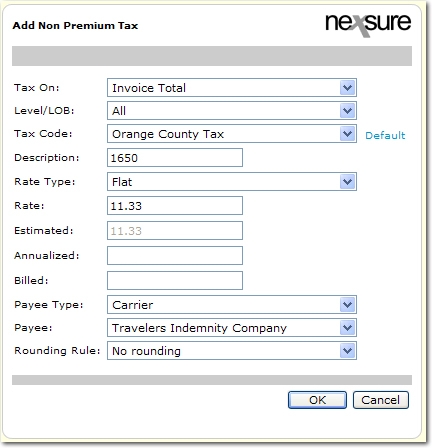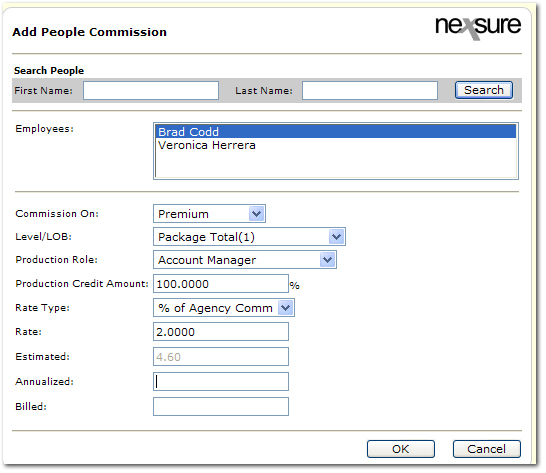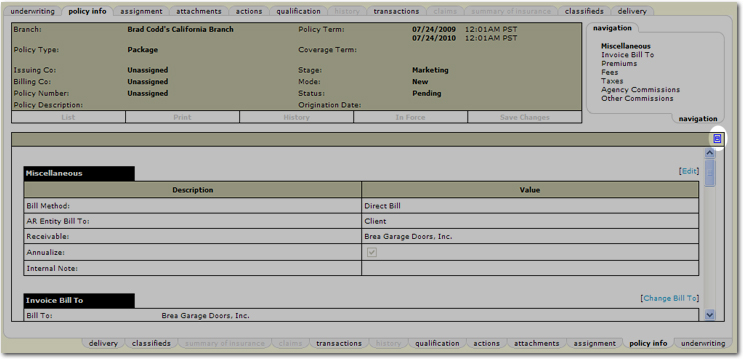
- If changes to the Taxes section are required, click the Details
 icon next to the tax to change. If a new tax is necessary, click [Add New Tax]. (The Taxable option must be selected in the Add New Fee dialog box.) The Add Non Premium Tax dialog box is displayed.
icon next to the tax to change. If a new tax is necessary, click [Add New Tax]. (The Taxable option must be selected in the Add New Fee dialog box.) The Add Non Premium Tax dialog box is displayed.
Note: Both the premium and the fee may be taxable.

- In the Tax On list, the selection determines where the tax will be applied.
Note: If Fee is selected, the Fee Code list will also be displayed.
- In the Level / LOB list, the selection determines to what LOB the tax will be applied.
- In the Tax Code list, select the name of the tax.
- Optionally, once the Tax Code has been selected, click Default. The remainder of the selections will be automatically entered with the defaults created in the invoice setup process.
- In the Description box, enter a description for the tax. This entry defaults to the description entered during the invoice setup process.
- In the Rate Type list, make a selection to identify if the rate will be a flat dollar amount or a percentage of items taxable.
- In the Rate box, enter the flat dollar amount or the percentage of items taxable for the tax.
- In the Estimated box, the estimated tax will be displayed.
- In the Annualized box, the annualized amount can be left blank as the Term Policy will now add to instead of replace the annualized amount.
- In the Payee Type list, make a selection to identify which entity is paid for the tax.
- In the Payee list, make a selection if the Payee Type selected is Tax Authority.
- In the Rounding Rule list, make a selection to control the rounding on the tax when a percentage has been applied.
- Once all selections have been made in the Add Non Premium Tax dialog box, click OK. The policy info tab is again displayed.

- If changes to the Other Commissions are required, click the Details
 icon next to the commission to update.
icon next to the commission to update.
- Click [Add New Other Commission] to add a new commission. The Add People Commission dialog box is displayed.
Note: If
default
commissions exist for Carrier, People or Fees, they will be created
automatically. Defaulted
commissions can be edited.

- In the Search People area, enter the first and / or last name of the employee.
- Click Search.
- In the Employees list, select the name of the employee with which to associate the commission. The default employee will be the employee that is assigned to the policy. Using the search function will return all policy branch employees.
- In the Commission On list, select the item on which the commissions will be based.
- In the Level / LOB list, the selection determines to what LOB the commission will be applied.
- In the Production Role list, select the role of the employee.
- In the Production Credit Amount box, enter the percentage of credit the employee will receive for bringing this piece of business to the agency.
Important: Upon saving the policy info, if the set up on the Invoice Defaults Tab requires the production credit to equal 100% upon putting policy info in force, if production credit is not equal to 100%, a dialog box will be displayed requiring that production credit line items are corrected to equal 100%. Any income bearing line item must have a related production credit line item total of 100%.
If the set up on the Invoice Defaults Tab allows production credit greater than 100%, while entering production credit line items, a warning will be displayed if production credit is greater than 100% but it will be allowed. Upon putting policy info in force, if production credit is less than 100%, a dialog box will be displayed requiring that production credit line items are corrected to equal or exceed 100%. Any income bearing line item must have a related production credit line item total equal to or greater than 100%.
- In the Rate Type list, make a selection to identify if the rate will be a flat dollar amount or a percentage.
- In the Rate box, enter the flat dollar amount or the percentage on which the commission will be based.
- In the Estimated box, the estimated commission will be displayed.
- In the Annualized box, the annualized amount can be left blank as the Term Policy will now add to instead of replace the annualized amount.
- Click OK. The policy info tab is again displayed.
- Use the [Auto-Allocate] feature to redistribute the production credit equally among all Other Commission line items. Click [Save] when complete. The distribution can also be changed manually by making entries in the Production boxes and clicking [Save].

 icon next to the appropriate client.
icon next to the appropriate client. icon next to the appropriate client.
icon next to the appropriate client.
 icon next to the third party commission to update.
icon next to the third party commission to update.